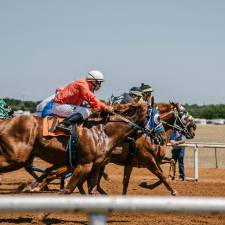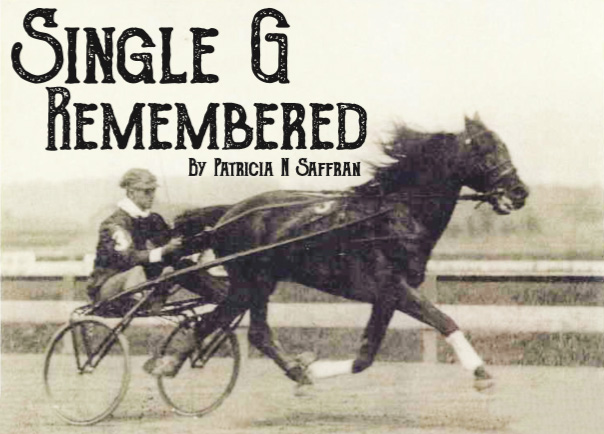
by Patricia N. Saffran
In April, I called Mary Jo Slonaker, the Cambridge City, Indiana authority on the horse Single G, who many consider to be the greatest Standardbred pacer of all time. He was born nearby on a farm in Centerville, Indiana, and Ms. Slonaker is the secretary treasurer of the Single G Association. I told her that I was going to do an article on him.
A few days later she said, “The whole town is excited. They’re going to plant new flowers around Single G’s monument so that we can take a better photo for you.” (The monument gives the horse’s dates, foaled 1910 died 1940, so the town is still honoring a horse that most today have never seen. The town marked Single G’s centennial on his birthday on April 4, 2010.)
Ms. Slonaker continued, “We used to have a Single G float, last seen in 1993, to mark the annual Indianapolis 500 Festival parade downtown, but now we just have the sign left, which I gave to the Richmond Museum nearby for their Single G Room.” I told Ms. Slonaker, “I don’t think there’s any European or American town that honors a horse in the way that your town does. I found out that you even have a mural devoted to the Single G on the side of the US Bank building downtown that was done very recently in 2010.” “Yes,” Ms. Slonaker said, “That mural is a big draw for tourists. It’s called ‘Single G in his Time’ by Pamela Bliss. People come from all over and drive to our town to see it. The honoring of Single G even extends into some of our residents’ homes. They have called me to say they have old wallpaper or hand painted décor of Single G that they refuse to redecorate or cover up. The town also has a thriving downtown with really good restaurants and shops, while other towns nearby are fading.”
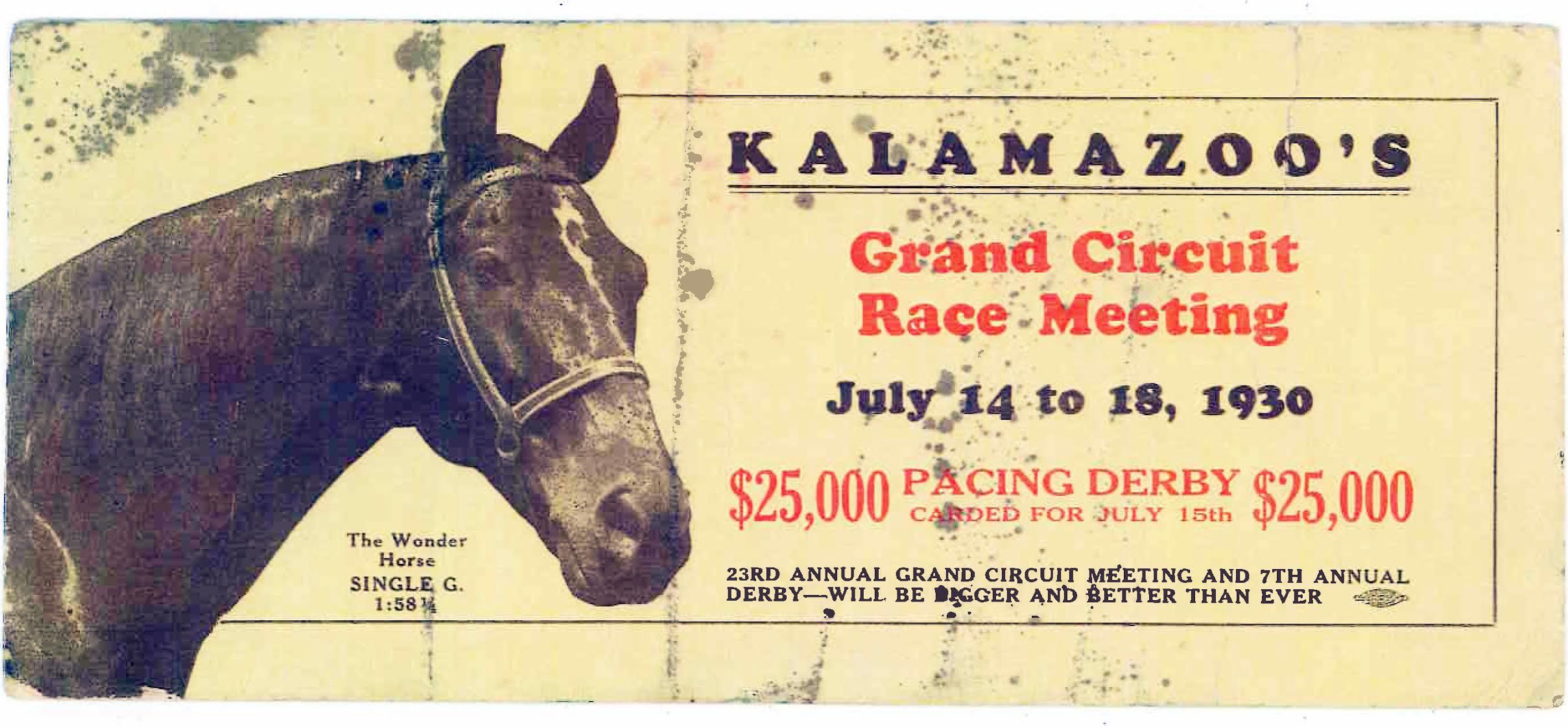
Ms. Slonaker went on to explain the town’s devotion to the horse. “Some people think he was the greatest race horse who ever lived. Racing until the age of 17, he was still regularly beating top horses, and even his own grandsons and granddaughters. His fastest mile, when he was 13, was 1:58 1/2, so he improved with age. Whenever I’m at harness racing events, people always come up to me and say, ‘Single G was sound, and fast. I wish I had a horse like him.’ He really was sound. He was only sick as a young colt and then once later, and he recovered. It helped that he only had one owner during the period of his racing career, William Barefoot, who, along with his brother, Eliam, took good care of him. When you think about horses today, that kind of health is rare.” I asked Ms. Slonaker, “With Single G’s record and astonishing long career, he should be better known. Why isn’t he?” She answered, “It’s because he was a harness horse, and in the world at large, there’s a lot of snobbism connected to Thoroughbreds. Standardbreds are looked down upon, but not in our town where the library history room is named the Single G Room.”
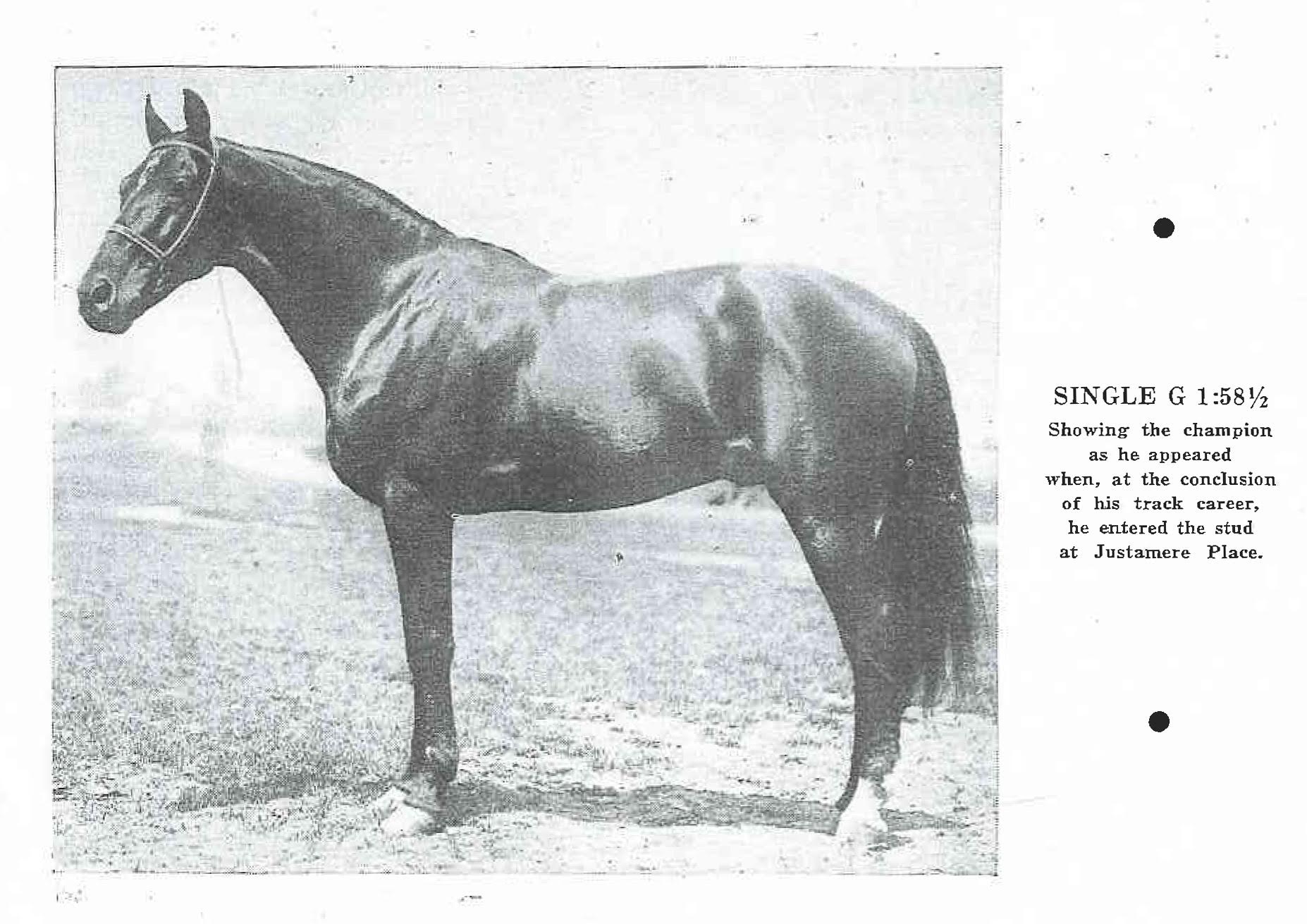
Named for the G shaped blaze on his forehead, Single G was born and raced during a period of county fairs combined with harness racing. There was also a special traveling racing series called the Grand Circuit. The top Standardbreds, drivers, trainers, and the politicians and high society all converged to watch harness racing on Grand Circuit days. Horse auctions were also held in some locations. Gentlemen driving clubs used the tracks as well as the pros, a practice that continues today, with amateurs competing. Ms. Slonaker explains, “The years, 1913 until 1926, when Single G was a harness racing wonder horse, were the years before there were movies, radios or TVs in America. The most important entertainment was a county fair, usually organized by state agricultural colleges. This was before 4-H of today which is for young students who live on farms. Local citizens could enjoy the carnival atmosphere and there was some betting, too. By word of mouth, everyone heard of Single G winning race after race. [Eventually he campaigned on the Grand Circuit, too.] The Barefoot brothers raced him in West Virginia, Michigan, Ohio, Pennsylvania, Illinois, Iowa, Nebraska, Georgia, Massachusetts, Maine, Windsor, Ontario, N. Brunswick, Canada and Indiana. Fourteen years of campaigning on mile and half-mile tracks. No other racehorse has a story like that.”
Single G, as one of the greatest harness horses, was a Standardbred, a breed that generally prefers either to trot or pace. During the turn of the century, Single G paced free-legged as a pacer while today pacers wear hobbles on their legs to enforce their gate. Standardbreds trace their ancestry to the stud duties in this country of the great English born Thoroughbred Messenger, who died on Long Island in 1808. Messenger’s blood lines may be found in many great Thoroughbreds and also top Standardbreds today. Single G is also related to Messenger’s grandson, Hambletonian 10, a Standardbred foundation sire to famous lines of trotters and pacers. John Hervey, in his book The American Trotter, 1947, believes that the Standardbred is a truly American breed. He thought that saddle or riding horses bred here had their antecedents in Europe but not so with the Standardbred.
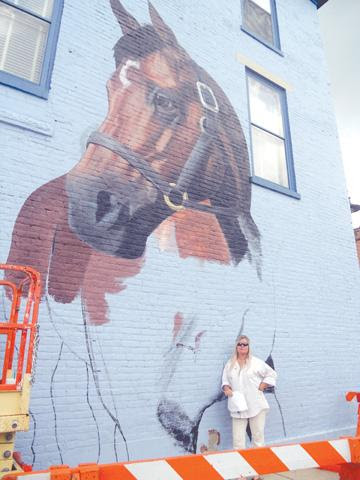
He writes, “The Standard-bred horse . . . is in the full sense of the term a fresh creation, unlike anything else of the kind previously in existence. Until his advent there was no such thing in the world as a true breed or type of harness race horse.” Single G was foaled in 1910, sired by Anderson Wilkes, who was owned by Lawrence Commons, Centerville, Indiana out of Little Gyp, who was owned by William Barefoot, Cambridge City. In 1912, Commons died and the story becomes a little murky. Author of the biography of Single G: The Horse That Time Forgot, 1968, Canadian born Marie Hill, told me over the phone from Grant’s Pass, Oregon, “After Lawrence Commons died, Single G, who was jointly owned, was sent to the sales to settle his estate, and was purchased at auction for $275 by H. S. Beard. Beard was bidding for Barefoot, who was out of town, to buy back the horse. Barefoot then became his sole owner. There was another horse jointly owned, [out of the same sire and dam] Grace D, who was born before Single G, and she also went to the sales.” The Harness Racing Museum’s book The Immortals, 1999, describes Single G, “From the ages of three until sixteen, ‘the wonder horse’ started in 434 heats and won 262, earning $121,125. He won 98 races, setting an all-time record. On September 26, 1923, Single G established a world record for four heats over a half-mile track when he won a match race at Bangor, Maine over Margaret Dillon 1:58 1/4 and Sir Roch 1:59 3/4. His fastest mile was 1:58 1/2 at the age of thirteen. Single G was retired at seventeen and sired 81 performers with Standard records. Later on he was known as ‘the horse that time forgot’ because he raced so well for so long.”
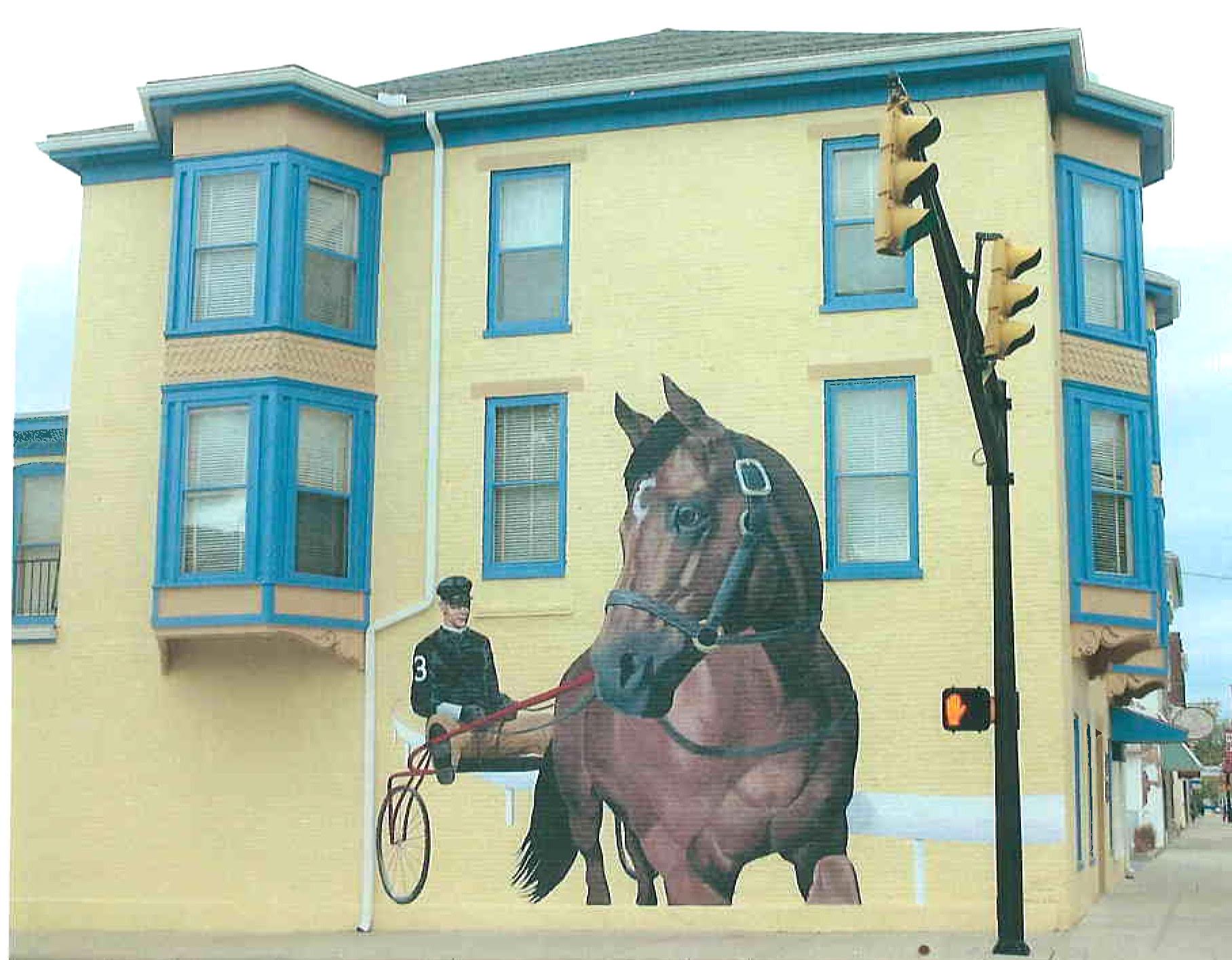
Assessing the brilliance of Single G, The Indianapolis News wrote the following in 1924, Single G Greater Than Dan Patch,Veteran harness horsemen, Clarence Cole, 92 years old; Walter McCord, 93, and Pearl Hungerford, 90, discussed Single G at the Indianapolis Fairgrounds: “Cole, a blacksmith, shod both Dan Patch and Single G, two of the greatest horses of the first quarter of this century. He said Single G was a greater horse then Dan Patch. Although they raced in different decades, Cole’s statement was believed to be true. McCord never missed an Indiana State Fair. He plans to attend it this year on Grand Circuit Day.” Discussing this article, Ms. Slonaker said, “I knew these horsemen and they really said that Single G was better than Dan Patch. We hear more about Dan Patch, who didn’t race as long as Single G, because his owner [Marion Savage] was a braggart and kept stirring up the press. William Barefoot was so proud of Single G. He felt he didn’t need to brag about his horse.”
The press in Indianapolis, Lexington KY and elsewhere covered Single G’s races in detail during his 14 year campaign, showing how much the press and the public cared about this dazzling pacer. The titles tell the story - Single G to Race Before His Friends; Single G Still At It; Greatest Race Event Ever Here (Henry County Fair); Single G Recovers From Illness – Will Race In Iowa; Single G To Race At Newcastle Fair Wednesday July 23; Single G’s Owner Robbed Beaten By Thugs; Harness Stars, Pacing King Single G And Crack Saddlers To Show At Fair Track June 7, and so on.
Ms. Slonaker explained more about local history, “There were other great harness horses in the Cambridge City area who all raced against each other. These horses and other famous harness horses are all highlighted in a cookbook that raised funds for the The Single G Association for the monument, Single G, The History of the Standardbred and Winning Recipes, 1976.” Each recipe is named for a historic pacer or trotter and includes information on the owners, races, and for some, where they stood at stud. The book was written by the late Dorothy Rose, who came from a family that breeds and trains Standardbreds. She also wrote two other cookbooks for the foundation. As to Marie Hill’s biography, Single G: The Horse That Time Forgot, it details the races of Single G with times and competitors. Ms. Hill told me that since she wrote the book in 1968, she has accumulated three file cabinet drawers full of documents on Single G and plans to write another more updated book. Ms. Hill said that one thing that most people do not know and that was not in her book is that the horse was fairly small, just 15 hands, and was more like a pony sized pacer. She also explained that his best time really was clocked at 1:57 but the official time was 1:58 1/2.
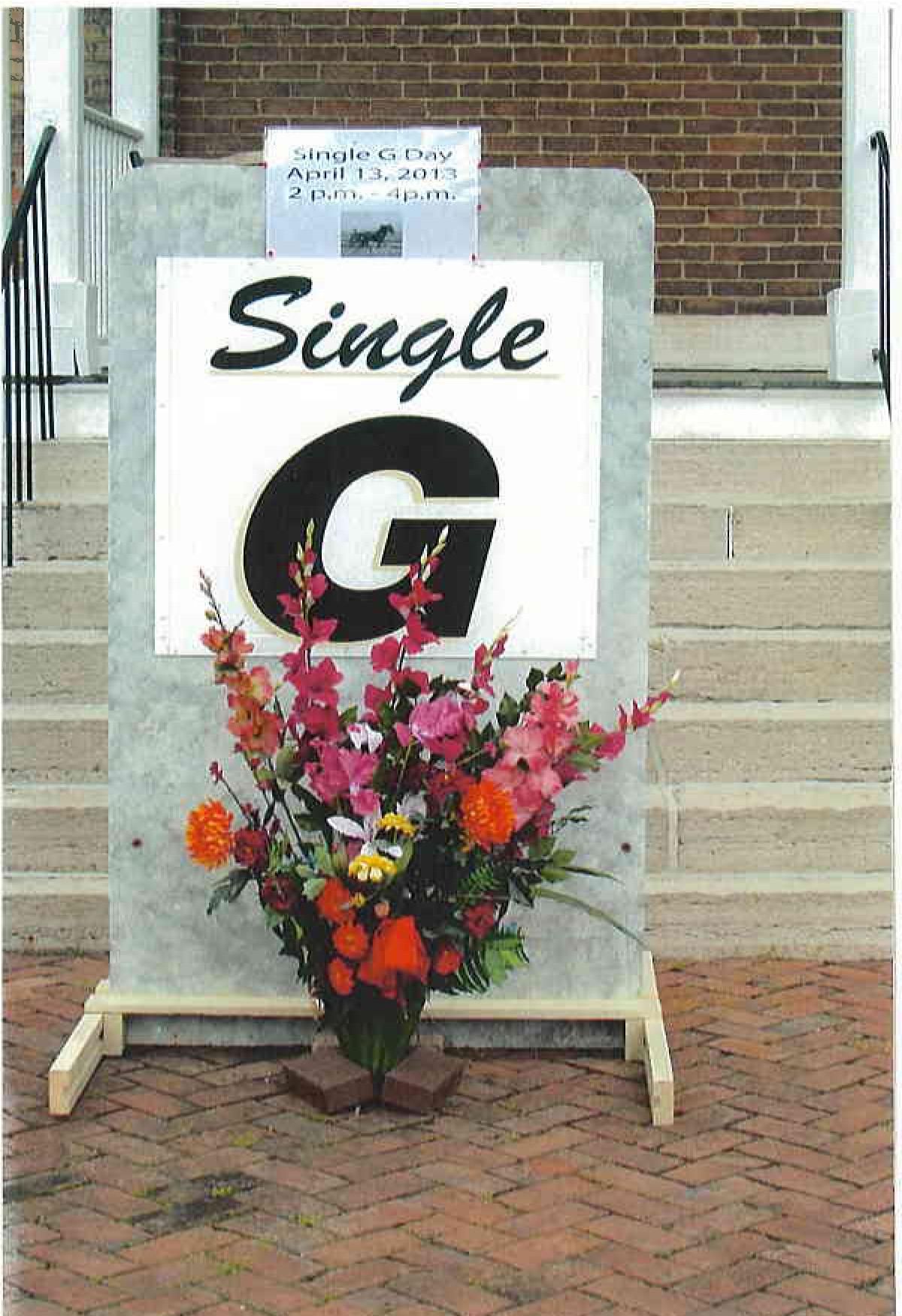
Commenting on the book, Laura Ann Robertson from Mission, SD, stated, “Single G was a great pacer. My great uncles, who were twins, trained and drove him. Their names were Ed and Hamy Allen. Ed was his driver. He made his fastest time when he was 13 years old. The only horse to beat his time was Dan Patch but the reason he did was Dan Patch used a wind shield when he made faster time. He was a great horse and much admired by racing fans and all who knew him.” Actually, both horses would have faster times if they had the advantage of the lighter, aerodynamic sulkies of today. Their races and those of another great early Standardbred, Billy Direct, when modern equipment is factored in, would place among today’s best Standardbred racing times.
The preface to Marie Hill’s book is by Carl Barefoot, nephew to the horse’s owner, William Barefoot. He describes Single G’s entry into the world. “I first saw him when he was but a few days old, a tiny bay colt with that famous white G across his forehead, standing quietly next to his dam [Little Gyp.] What was Single G like? In courage, gameness, disposition, and perfection he stood alone; he had a dignity about him which goes with a true champion, and he loved two humans above all others, his owner William Barefoot and his devoted driver Ed Allen.” Carl Barefoot also states, “Dick [Single G’s stable name] was a very friendly fellow and never seemed to tire of visitors . . . The bond between owner and horse was touching to behold.”
In her book, Ms. Hill describes the colt nearing his second birthday, “Single G . . . was still unbroken, and this was beginning to cause his owners some anxiety, for it had been noted of late that the colt displayed on numerous occasions a very bad temper; he was stubborn, wild and independent . . . he could kick and strike. It was therefore decided that his education to harness should commence immediately.” When the colt became quite ill, and was still not trainable, William Barefoot stood a twenty-four vigil next to him and nursed him back to health. After that, Single G became a different horse, as if he were grateful to Barefoot for standing by him. Local trainer Howard Vick - ery had no trouble breaking him to harness. His long time driver Ed Allen said that Single G was “playful” and always returned affection, but was never bad tempered. Farrier Clarence Cole said, “ ‘I made and applied the first shoes ever worn by Single G when he was a three year old. He stood quietly showing no anxiety, and it remained through the years. He would on occasion look around to see what I was doing or to hurry me along with my task. He was a truly wonderful horse, and in my opinion – and I’ve seen all the great ones – he was the greatest pacer of all time, and to say he was ill-tempered does him an injustice.’ ” Also in the book, William Barefoot explained to his nephew, “ ‘He seems to have a perfect understanding with me . . . I say ‘hello, Dick’ and then he puts his head over my shoulder and I give him a chew of fine cut tobacco, of which he is very fond. I carry a big bunch of carrots to him every morning and he is fed a lot of them and when race day comes he has an extra portion, as he eats carrots all the time between heats.’ ”
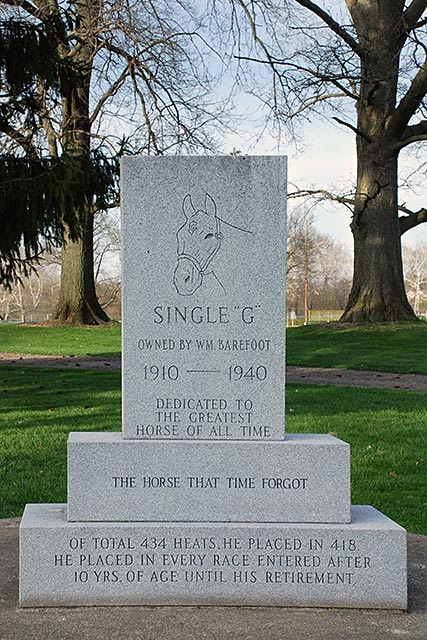
Ms. Hill writes that William Barefoot “would not tolerate any unjust abuse of Single G, neither with the whip nor loudness of voice.” He refused the services of the famous driver and his friend, Ed ‘Pop’ Greer, because apparently Barefoot said, “he touched Dick once too often with that whale bone.” Ms. Slonaker knew William Barefoot and explained, “He was a gentleman, a sweet guy and he loved the horse. He always made sure the horse was well treated. You could say he would be considered a natural horseman today. The horse was known to have a great personality and liked to show off. It’s com - mon knowledge that at the Indianapolis State Fair one time toward the end of his racing career, there was lots of applause for Single G. He was led toward the grandstand and did his famous stiff legged walk with his head held high.” I told Ms. Slonaker, “I saw John Henry in retirement at the Kentucky Horse Park do the same strutting stiff legged walk when his name was announced, and it wasn’t just his arthritis making him stiff. He was showing off for the audience, too.”
As to Single G events in our times, I asked Ms. Hill about who of the Barefoots takes part in the celebrations. She answered, “I’m in touch with the grandchildren [who do not live in Cambridge City] and they have no interest in taking part in any events remembering Single G. Years ago, I spoke to Har - old Savage, the grandson of Dan Patch’s owner. He said that in the 1930’s he was on business in Indiana, and he drove 40 miles out of his way, which was a lot in those days, to pay his respects to Single G.” So great was the horse’s reputation that a rival horse’s family had to visit him.
Article courtesy of Horse Directory Magazine
Photos: Single G racing, photo courtesy of Mary Jo Slonaker; Single G memorabilia, photo courtesy of Mary Jo Slonaker; Single G, photo courtesy of Mary Jo Slonaker; Pamela Bliss working on mural of Single G at U.S. Bank building, photo courtesy of News Examiner; Single G mural, U.S. Bank Building, photo courtesy of Mary Jo Slonaker; Single G Day, photo courtesy of Mary Jo Slonaker; Single G Monument, photo courtesy of Discover Wayne County.









